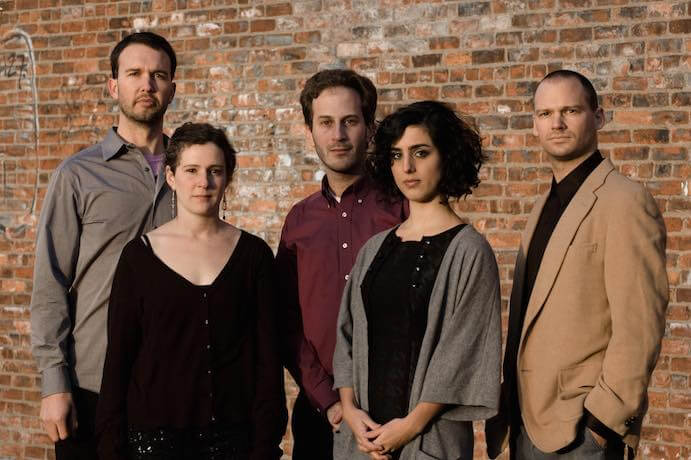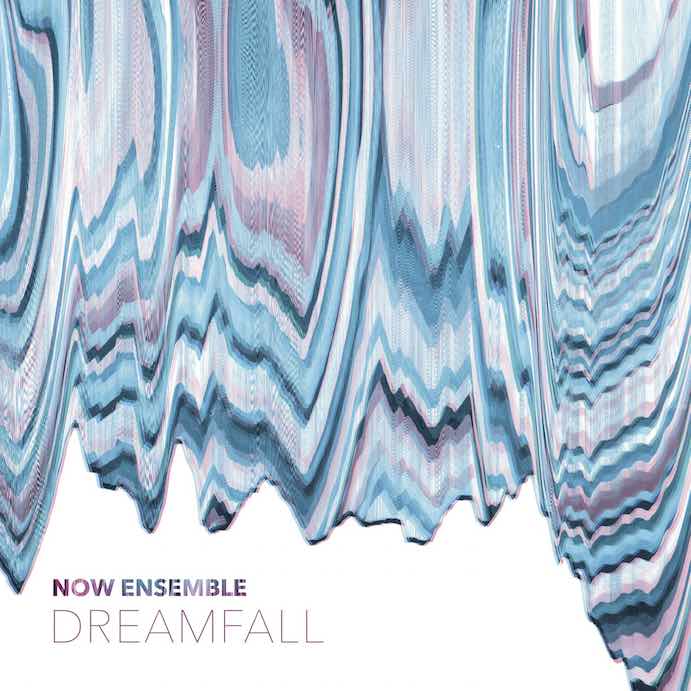Set aside any preconceived notions of what is “classical music” and listen to Dreamfall, NOW Ensemble‘s third CD for the enterprising New Amsterdam Records label. NOW creatively thrives in a marriage of classical, rock, and jazz, with classical chamber music forms and concepts as the framework. Like a text book marriage, there is give and take, respect, arguments, and even a little naughtiness thrown into Dreamfall‘s program of nine recent works exploring themes of dreaming, connecting, creating, and transforming.
The ensemble describes itself as “…a dynamic group of performers and composers dedicated to making new chamber music for the 21st century.” Fostering this spirit of collaboration, composers Patrick Burke, Judd Greenstein, and Mark Dancigers are considered integral members of NOW, however Burke’s works are not featured on this CD. Instrumental members Sara Budde (clarinet), Logan Coale (bass), Mark Dancigers (electric guitar), Michael Mizrahi, (piano), and Alex Sopp (flute) form a versatile ensemble that coaxes an amazing range of color and textures from non-typical instrumentation.
Opening the CD is the atmospheric “Still in Here” by sound artist and composer Scott Smallwood. “Still In Here” is dominated by dark rumbling piano ostinato, and rustling, disconcerting electronic sounds evoking menacing night sounds both real and imagined. The ten-minute miniature tone poem builds in intensity with minimal material or development before fading into eerie quiet. “Still in Here” could be called Ives’ Unanswered Question recomposed for the 21st century; a persistent, two note falling figure brought that work’s “question” trumpet motif to mind. Is it a burning question or obsession robbing us of sleep, or perhaps a foghorn sounding a distant warning? As with the Ives, you can just hear monotony or you can open the mind and ear to the almost imperceptible changes in pulse, musical drama and volume.
Mark Danciger‘s “Dreamfall” (I, II, III) is a complete contrast to “Still in Here” and a most effective stroke of programming. In “Dreamfall I,” the menace is gone and dreams take over. A simple, liquid piano theme gradually builds in complexity and spirit as the ensemble joins. “Dreamfall II” opens with an echo of Bach in the cello and piano but quickly erupts into a brightly colored, energetic, and rhythmically-hypnotic dance. “Dreamfall III” takes the dream-journey to its conclusion; wistful, glancing backwards to where we came, but full of optimism. The textures here are fuller and almost symphonic at times, but never so dense that we can not enjoy the contributions of the entire ensemble. “Dreamfall’s” harmonies are tonal and the sounds from the instruments mostly conventional but always used with masterful imagination and delicate balance such as the energetic center section of “Dreamfall II,” with its intricate and finely balanced electric guitar, piano, and bass. This work is well-deserving as the CD’s title track.
John Supko‘s “Divine the Rest” is the least formally conventional work on the program. Supko uses a “generative” process to “engineer musical serendipity” based on collected harmonies, melodic cells, spoken texts, and sound fragments. The ensemble is given some minimal notated material: single notes, maybe a chord or two, but no indication of rhythmic values. Their playing responds to whatever sonic environment is created by the always-evolving computer manipulation of the sound fragments– in this case, nature sounds and snippets of spoken text. Frankly, it comes off as one of those “new age space music” pieces you frequently encounter on late evening radio. “Divine the Rest” serves as pleasant mediation in the middle of the more energetic/active works, but the composer seems to go to great lengths to create a piece that really says little.
Suffolk, England based Nathan Williamson‘s “Transatlantic Flights of Fancy” celebrates musical collaboration and musical communication from diverse sources, places, and cultures. Two contrasting musical ideas and moods, one ringing, declamatory, and energetic and the other contemplative and flowing, are presented, expanded, and ultimately merge into one. As with a composer on one side of the pond and the performers on the other, “Transatlantic Flights of Fancy’s” two ideas often move independently and even clash. Contrapuntal ideas come and go; the piano, flute, and clarinet argue with the electric guitar, but despite the differences and diverse thoughts, they all come together quite effectively in the end. Restless, creative, and upbeat, “Transatlantic Flights of Fancy” deserves a place in the new music standard repertoire.

NOW Ensemble
NOW Ensemble inserts works with genteel personalities and linear development that serve as a divertissment between the more frenetic “Transatlantic Flights of Fancy” and Judd Greenstein’s “City Boy” which follows. Sarah Kirkland Snider’s “Pale as Centuries” gets a lot mileage out of the simple guitar figure that opens the work. “Pale as Centuries” builds in intensity and drive as the full ensemble enters, expanding the opening figure and introducing new material all while moving from musical collage to a single, organic musical statement. Andrea Mazzariello‘s “Trust Fall” is a slowly unfolding rhapsody, tinged with sadness and a touch of drama.
Melodies, figures, riffs, textures, and moods dart about in Judd Greenstein‘s “City Boy,” sometimes returning, sometimes abandoned in mid-thought. Our “City Boy” is taking in all the sights and sounds of his bright and busy urban environment, sometimes understanding, sometimes looking wide-eyed and agape at what passes by. Witty, charming, even a touch jazzy, sometimes bringing to mind the sophisticated and brilliant scores of the “Peanuts” cartoon specials, “City Boy” brings the program to a playful close.
The technical excellence of NOW Ensemble and their obvious affection and connection to the works on Dreamfall contributes much to the success of the album, as do the clear and bright sonics that allows us to hear the intricate interplay and the imaginative and innovative sound of the ensemble. They challenge, inspire, and collaborate as a fine-tuned ensemble should: anticipating each other’s moves while skillfully blending their voices into a collective voice. No one member stands out, and that is just fine– each member contributes their unique sound and vitality to the whole.
So is all this “classical music,” “jazz,” “pop,” “indie-classical…?” The nine pieces comprising Dreamfall may be difficult to label, but no matter– this is fresh, exciting, accessible, fun, and yes, “NOW” music that is continually imaginative and engaging.























